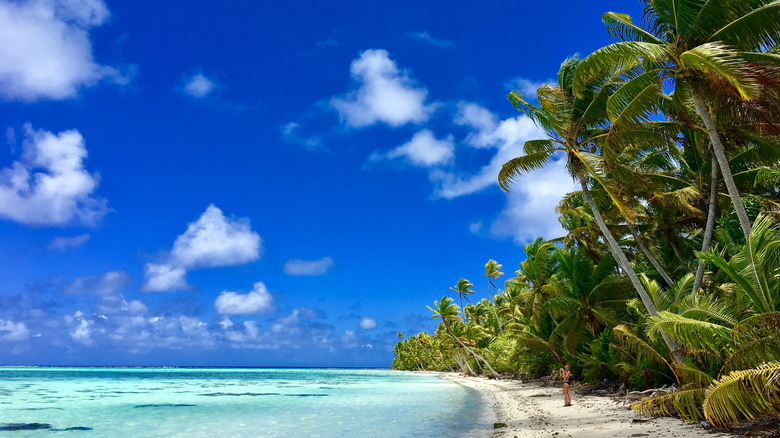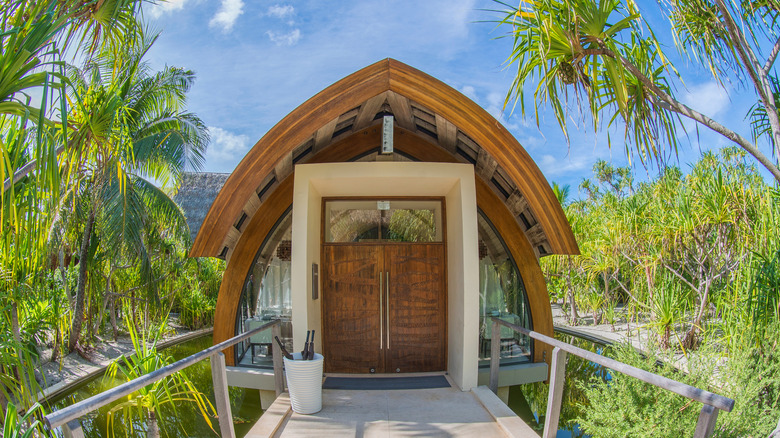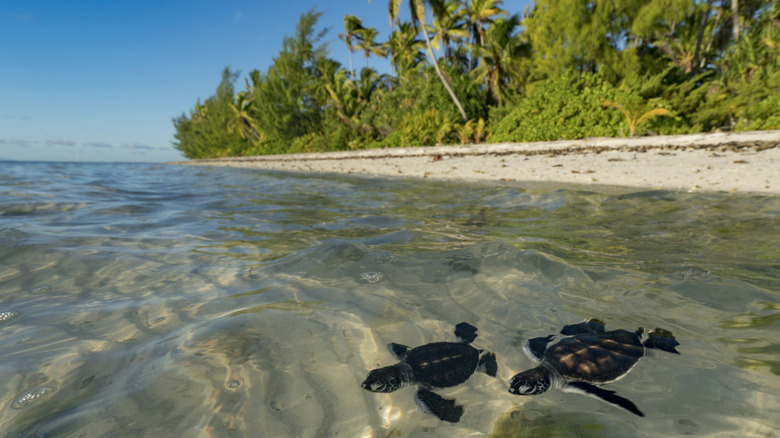A Wildly Luxe Eco-Conscious Island Resort In French Polynesia That's Mostly Mosquito-Free
Home to five separate archipelagos containing over 130 islands and atolls, French Polynesia just may be the crown jewel of the South Pacific. This string of once-volcanic outcroppings is renowned for its white sand beaches, deep azure waters, breeze-blown palm trees, and low-lying reef islets known as "motus." From iconic Tahiti to the turquoise lagoon of Bora Bora and the snorkeling haven of Mo'orea, French Polynesia has long attracted visitors searching for a sun-kissed slice of tropical heaven.
It should come as no surprise that this has also included the rich and famous. Perhaps most notable is actor Marlon Brando, who, when scouting locations for his film "Mutiny on the Bounty" in 1961, fell in love with the idyllic atoll of Tetiaroa. Once a retreat for Polynesian royalty, Brando managed to purchase the property and used it as his private refuge until his death in 2004.
Brando was determined to preserve the natural splendor of Tetiaroa and its 12 motus while also making it possible for guests to soak up the magic that he had enjoyed for so long. Today that dream has been realized in the form of The Brando, an upscale eco-resort that operates on the principles of low-impact, sustainability, and — for its guests — absolute privacy. To top things off, visitors to this one-of-a-kind hideaway can relax knowing that they won't be swarmed by mosquitos, as they've been largely eradicated from the atoll.
The story behind this piece of paradise
Situated just 30 miles north of French Polynesia's big island of Tahiti, Tetiaroa was originally a sacred gathering place for tribes. Polynesian royalty eventually made the atoll their personal getaway, using it for entertaining and as a place for soon-to-be-married daughters to relax. It is also said that both local kings and Spanish explorers hid their treasure among the motus.
Marlon Brando was smitten by the atoll at first sight, eventually purchasing the 99-year lease granting him sole ownership in 1966 for the sum of $270,000, which is about $2,500,000 in today's money. He was taken by the pristine state of the place, and vowed to preserve it, teaming up with hotelier Richard Bailey to plan a luxury resort that would embrace the ideal of ultimate sustainability. Brando never lived to see this vision become a reality, but his children, who inherited Tetiaroa in a trust, came to an agreement with Bailey's company, Beachcomber, in 2009. Beachcomber was granted a 99-year lease on two of the motus, while the rest are protected from any construction or development, and in 2014, The Brando welcomed its first guests.
The Brando is made up of 35 villas tucked away amongst the palm trees, offering the utmost in privacy, which makes it very desirable for celebrities wishing to avoid the camera's glare. In fact, guests are made to sign a pledge to refrain from photographing anyone outside of their party. That said, the atoll's raw, dreamy, technicolor beauty is the main draw. It's why Brando fell in love with Tetiaroa in the first place, and made it his mission to preserve it. "Tetiaroa is beautiful beyond my capacity to describe," he said.
A green dream amidst the ultimate in South Seas scenery
The Brando has embraced the late actor's ideas about ecological responsibility and sustainability in some remarkable ways. The landing strip (guests are flown in from Tahiti's capital, Papeete, via private plane) is surrounded by thousands of solar panels, which provide much of the power to the resort. Two gargantuan food digesters turn food waste into compost, the toilets are fueled by rainwater, and half of all materials used on the island are recycled and reused. Most impressive, however, is The Brando's cooling system, which takes seawater from nearly 3,000 feet below the ocean's surface into a "closed loop heat exchanger" to feed the complex's air conditioning.
If there was ever one drawback to life on Tetiaroa, it was the mosquitoes, which were known to be numerous, persistent, and very aggressive. Thanks to the efforts of Doctor Hervé Bossin of the Institut Louis Malardé and the nonprofit Tetiaroa Society, the mosquitoes of Tetiaroa are largely no more. Millions of non-biting male mosquitoes infected with a bacteria that makes the biting females sterile have been released at Tetiaroa, reducing the swarms by around 95%. On top of that, the tilapia farmed in freshwater ponds on the atoll feed on mosquito larvae, which further guarantees you won't be dive-bombed at night.
All of this, of course, comes at a cost. The Brando is a super exclusive, high-end destination with the kind of price tag you would expect from such an establishment However, for those with deep pockets keen to experience French Polynesia at its most isolated and sublime — while also supporting conservation and sustainability — there's no better choice. For more environmentally-friendly accommodations in the heart of nature, check out this eco-lodge tucked away in the Central American jungle.


